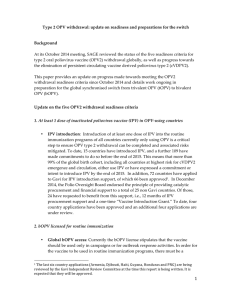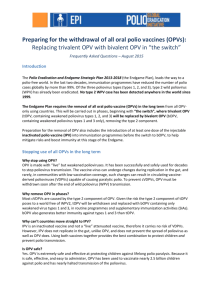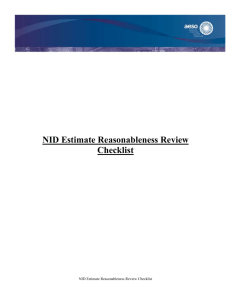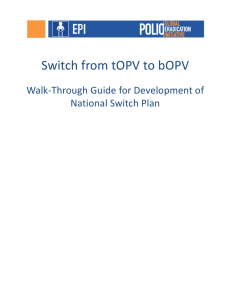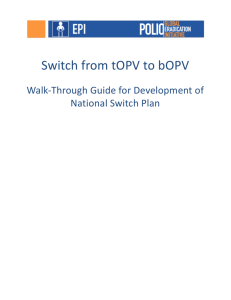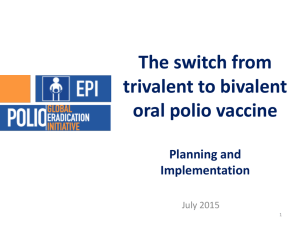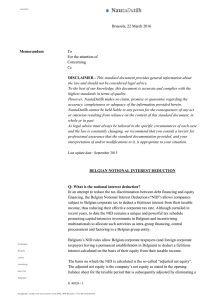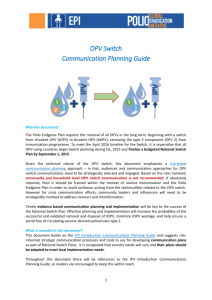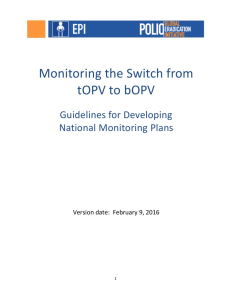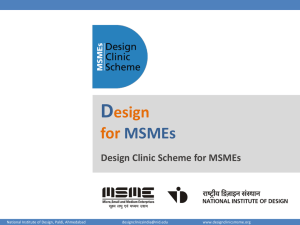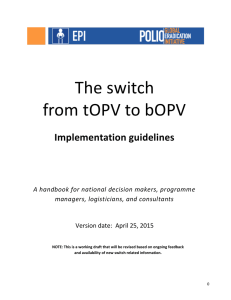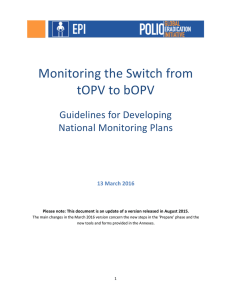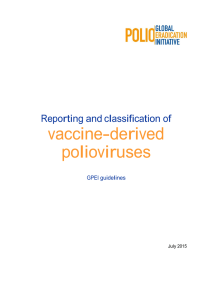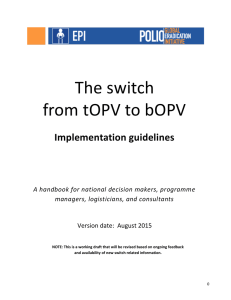PolioEndgame_DrSunil..
advertisement
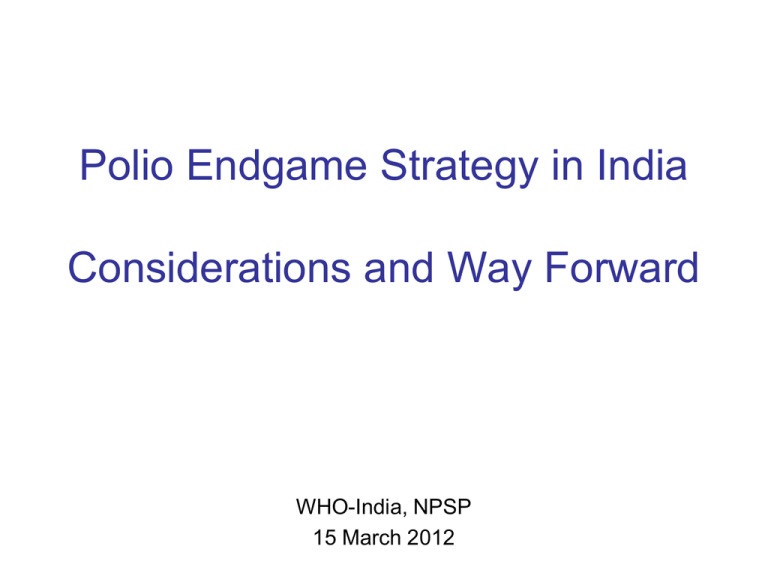
Polio Endgame Strategy in India Considerations and Way Forward WHO-India, NPSP 15 March 2012 Outline of the presentation • Background/Context • Considerations • Possible Way forward Context • No WPV2 in India since 1999 • tOPV used in RI and during NIDs • bOPV used in most SNIDs since Jan 2010 • Areas and populations with low routine immunization coverage • All cVDPVs in India due to type 2 in setting of low immunity to type 2 Last wild poliovirus cases by type, India WPV2 24/10/1999 Aligarh (UP) WPV3 22/10/2010 Pakur (JH) WPV1 13/01/2011 Howrah (WB) Current pattern of vaccine use-India • tOPV – EPI schedule: 6,10,14 wks Birth dose for institutional births – SIAs: 2 NIDs with tOPV each year Assessed tOPV3 coverage by CES 2009 A • bOPV – Introduced in Jan 2010 – Used extensively during SNIDs in high risk states/ areas 70.4% <60 60 - 70 70 - 80 >= 80 cVDPV cases, India 2009-2011 •cVDPV cases detected in 2009-10 •100% due to type 2 Type 2 District 2009 2010 2011 Badaun 3 0 0 Bulandshahar 2 0 0 Ghaziabad 0 1 0 Meerut 2 0 0 Moradabad 2 0 0 Pilibhit 4 0 0 Shahjahanpur 2 1 0 Total 15 2 0 Low seroprevalence against poliovirus type 2 Results from different serosurveys Moradabad Nov 2007 (N=121) AFP cases UP Nov 08 – mid 09 (169) Moradabad May 2009 (N=534) UP & Bihar Aug 2010 (N=1280) UP & Bihar Aug 2011 (N=1246) 6-7 mo 6-11 mo 6-7 mo 6-7 mo 6-11 mo Type 1 78% 96.5% 99% 98% 98.5% Type 2 56% 33.7% 75% 65% 85% Type 3 69% 42.6% 49% 77% 88.2% Age Evaluated OPV3 coverage by district – DLHS 3 (2007-08) and cVDPVs State.shp District.shp 0<-25% 24.9 25 49.9 25-to 50% 50 74.9 50 to 75% 75 100 >=-75% Uttar Pradesh N cVDPV type 2 W 0 200 400 Miles S 10 tOPV tOPV sNID NID 9 tOPV NID tOPV sNID 8 7 tOPV c VDPV type 2 Number of cases 200 E 6 5 4 3 2 1 0 J F M A M J J A S O N D J F M A M J J A S O N D J F M A M J J A S O N D 2009 2010 2011 iVDPV & aVDPV cases, India 2009 to 2012* iVDPV State Chhattisgarh Punjab Tamil Nadu Uttar Pradesh Odisha Total *: data as on 10 March 2012 Type 1 Type 2 aVDPV Type 3 1 1 1 1 1 1 3 1 State Type 1 Assam Bihar Karnataka Madhya Pradesh Rajasthan Uttar Pradesh West Bengal 1 Total 1 Type 2 3 1 1 1 4 1 11 ambiguous VDPV (aVDPV): origin uncertain e.g. single isolate from single AFP case, non-immunodeficient person Managing the risk of VDPVs tOPV-bOPV switch in India? Considerations • • • • Pre-switch increase in type 2 immunity Rapidly improve routine immunization coverage Use of IPV in conjunction with bOPV/tOPV to reduce risk of emergence and consequences of cVDPV Availability of vaccines – IPV availability for use in routine immunization – bOPV availability for routine immunization and SIAs • • Management of post-switch risks of type 2 VDPVs cVDPV type 2 circulation stopped everywhere & switch synchronised globally Pre-switch boosting of type 2 immunity • Switch soon after tOPV NIDs • Improve RI, particularly DTP3 and OPV3 coverage • Adding a dose of IPV in RI for infants prior to switch IPV introduction • Benefit – impact on RI ? • Timing/Age/Doses/Route – follow global SAGE recs ? • Frequency: 2 doses in known cVDPV risk areas? Modelling and Research in the India context may help optimise strategy for India bOPV availability • Licensure and pre-qualification of additional manufacturers to meet requirements of India pre and post-switch bOPV assessment study to support licensure of additional manufacturers Post-switch VDPV type 2 risk management • Heightened surveillance to detect postswitch Sabin type 2 (not just VDPV type 2!) • Stockpile/ Capacity to produce mOPV2 at short notice Certification standard surveillance to continue beyond certification Polio Endgame Strategy-India, Possible Way Forward tOPVbOPV switch Polio certification Last WPV case NID NID NID NID NID NID NID IPV NID Modelling, Research, Development PQ/ licensing, stockpile Postswitch Sabin type 2 risk mgt. Certification standard surveillance, improved RI coverage 0 Jan Mar May 2011 Jul Sep Nov Jan Mar May Jul 2012 Sep Nov Jan Mar May Jul 2013 Sep Nov Jan Mar May 2014 tOPV NID Conclusions • India can be in a position to move ahead with polio endgame strategy • Careful planning and consideration of risks required before implementation • Earliest possible timing for tOPV-bOPV switch: Qtr.1 2014 • Lessons from tOPV-bOPV switch significant for subsequent withdrawal of all OPV from programme
